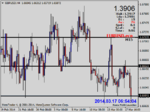Technical Outlook
EURJPY 24th March 2014:
Technical outlook and chart setups:

1. The EURJPY pair has remained in an uptrend since June-July 2013, printing higher highs and higher lows. The run-up has been stalled at 145.50, before pulling back recently. The trend line support is seen at 139.00 levels for now. A break below 139.00 would prove to be potentially bearish. At this moment, it is recommended to remain flat. Aggressive trade setup is to initiate short positions, risk remains above 144.00.
2. Immediate intermediary supports are spread through 139.00, followed by 136.50, 134.00, 131.00 and lower, while resistance is at 144.00 (intermediary), followed by 145.50 respectively.
3. The structure reveals that bears might want to push prices below 139.00 and further looking at the weekly chart. Although, keeping the long term uptrend into consideration, 136.50 should break to confirm a meaningful bearish setup.
Trading recommendations:
Remain flat for now. Aggressive trade setup is to initiate short positions, stop at 144.00, and target open.
GBPJPY 24th March 2014:
Technical outlook and chart setups:

1. The GBPJPY has remained in an uptrend since 120.00 levels now and a major resistance block at 163.00 has been cleared recently by bulls on the weekly chart view. At the moment, prices remain supported at 168.70/80 levels (trend line). However, a break here, would open up doors towards 160.00/50 levels. It is recommended to remain flat for now and wait for a reaction at the trend line.
2. Intermediary support is at 164.00, followed by 160.00 (trend line), 158.00, 156.50 and lower, while resistance is at 173.60, followed by 174.80 respectively.
3. The structure reveals that GBPJPY bulls shall remain in control till prices are above 164.00 levels. But it is still suggestive to wait for confirmative push above 170.00 before committing longs.
Trading Recommendations:
Remain flat for now. Look for further evidence to commit.
EURAUD 24th March 2014:
Technical outlook and chart setups:

1. The EURAUD pair has been printing higher highs and higher lows since 1.15 levels forming an inverse head and shoulder reversal on the weekly charts. At the moment, it looks like a meaningful correction is due, and hence recommendations are not to commit on the long side. Prices are supported at a past resistance turned support around 1.5 levels for now. A break below the trend line and further below 1.5 would prove to be extremely bearish.
2. Immediate intermediary support is at 1.5, followed by 1.44, 1.41 and lower, while resistances are spread through 1.55 and 1.58 respectively.
3. The structure reveals that 1.5 needs to hold for bulls to remain in control. Please also note that prices are right at the trend line support around 1.5180, and a break down would be encouraging for bears. A possible head and shoulder reversal could be shaping up with 1.55 being defined as the right shoulder and 1.58 and head. Prices need to remain below 1.58 though.
Trading recommendations:
Remain flat for now. Look to sell on a possible break of trend line.
Crude Oil 24th March 2014:
Technical outlook and chart setups:

1. As seen here on the weekly chart, Crude remains in a broader trading range, with increasing supports (75.00, 77.00, 85.00 and 91.00) and constant resistance (110.00/111.00); since June 2012. Recently, prices bounced off the support at 91.00 levels and rallied through 105.00 before pulling back again. At the moment, prices seem to be bouncing off the 96.50 levels; please note that Fibonacci 0.618 support is also around the same region. Also, an engulfing bullish signal has appeared on daily charts.
2. Immediate intermediary support is at 97.00/96.50, followed by 91.00 and lower, while resistance is at 103.00, 105.00 and 110.00 respectively.
3. The structure reveals that a test of 96.50 levels is still possible before bulls resume the next leg high. Trade strategy should be to buy on dips for now. 91.00 levels remain key for bulls to remain in control.
Trading recommendations:
Initiate 50% long positions, and remaining 50% around 96.50, stop at 94.00, and target open.
Gold 24th March 2014:
Technical outlook and chart setups:

1. A daily chart view has been presented here that shows potential double bottom formed at around $1,180.00 levels. The rally since then has taken out major resistances at $1,361.00 and $1,375.00 respectively. A meaningful pullback/recovery could be under way at the moment towards possibly $1,250/60 levels before the next Bull Run resumes. Prices are been supported by the rising trend line at the moment and a break would be required to confirm further lower side.
2. Immediate support is the $1,300.00/10.00 region, followed by $1,280.00/70, 1,230.00/40.00 and lower, while resistances are spread through $1,388.00, followed by $1,395.00 and higher respectively.
3. The structure reveals that Gold has turned back from $1,388.00 levels in a pull back / retracement mode for the time being. Trading strategy should remain to buy on dips.
Trading recommendations:
Remain flat for now. Look to buy lower.
Silver 24th March 2014:
Technical outlook and chart setups:

1. Silver is pulling back for the time being, after printing highs at $22.30 levels recently. Please note that Fibonacci 0.618 support is at $20.00 levels and also the past resistance turned support region at current levels. A bullish reversal here should be bought with minimum upside targets of $23.00 and higher.
2. Immediate support is at $20.00, followed by $19.00, $18.70 and lower, while resistances are spread through $21.70/80, followed by $22.30, $23.00 and higher up respectively.
3. The entire structure reveals that Silver could have possibly turned bullish after breaking the resistance trend line as seen here. Furthermore, a bullish bounce at sub $20.00 levels would bring back bulls in control and push prices higher towards $23.00 and $24.00.
Trading recommendations:
Initiate long positions at $20.00, stop at $19.25, and target open.




























